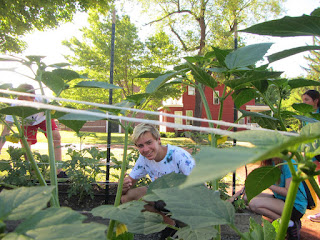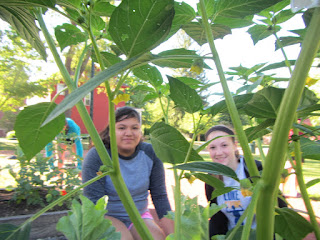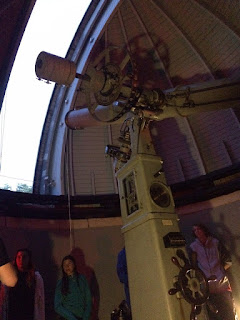Today right after eating a scrumptious breakfast at
McKinleys, we went to the student run garden by the Carr building, the Carrden.
At the Carrden Kerstin Martin, garden
manager here at AC, helped us learn about all the types of plants there and
about how and why the Carrden is used
and was created. The Carrden sells their produce to the cafeteria’s here at
Allegheny College and it is part of what wwe eat for breakfast lunch and dinner
While at the carrden we, the creekers, helped to install a new irrigation
system by connecting plastic tubes with holes in them to an intake system to
which one can attach a hose to get the water to the plants. After making two of
these to water the eggplants and tomatoes we moved over to planting
different plants. We planted kale and then watered it. We planted two different
varieties of kale filling an entire planter. 


Freshwater Academy is a week-long camp that gives high school students the opportunity for hands-on experience and fieldwork in Northwestern Pennsylvania's waterways. Students spend their days studying biology and freshwater ecology at a level they can't achieve in the classroom. They will get wet, they will get dirty, and they will love it!
Thursday, June 30, 2016
Who lives in a pineapple under the creek?
....SPONGES
(even though we did not find any)
On Thursday we were given the task to find different kinds of sponges in French Creek. Unlike dish sponges, these freshwater sponges were multicellular organisms that attach to a firm surface. Sponges have simple bodies and have numerous microscopic holes that let water pass through and a few larger holes that let water escape. The sponges presence indicate high water quality and low levels of pollutants. We learned that a sponges have very hollow bodies and hold its shape with the help of mesohyl, a jelly-like substance made from collagen.


With our snorkels and masks we headed out into the creek to look for sponges. However we found no sponges but campers were able to find catfish, crawfish and a leech.
(even though we did not find any)
On Thursday we were given the task to find different kinds of sponges in French Creek. Unlike dish sponges, these freshwater sponges were multicellular organisms that attach to a firm surface. Sponges have simple bodies and have numerous microscopic holes that let water pass through and a few larger holes that let water escape. The sponges presence indicate high water quality and low levels of pollutants. We learned that a sponges have very hollow bodies and hold its shape with the help of mesohyl, a jelly-like substance made from collagen.


With our snorkels and masks we headed out into the creek to look for sponges. However we found no sponges but campers were able to find catfish, crawfish and a leech.
Something's goin' down... wayyy up.
On Wednesday, the Creeker family went to the observatory to learn about space and the night sky. Dr Lombardi, the astronomy professor at Allegheny, pointed out things to find. He showed us constellations and we learned how to spot satellites as they pass by. We were able to look through the telescopes to get a close view of some of our neighboring planets. With much clarity we saw the rings of Saturn as well as the moons of Jupiter. Inside the observatory, we learned how to operate the huge telescope. We oriented the observatory the same way they did when it was built in 1901. The dome roof was spun in a circle with a gear that a camper would rotate with a thick rope. Even though the observatory and its telescope was over 100 years old, we were able to see planets, galaxies and a star cluster called M-15. This particular star cluster is only 50 light years across but it harbors over 500 thousand stars. It looked like a cloud of dust in front of a pitch black canvas, but each spec of dust was a star!


Wednesday, June 29, 2016
Bats With Terry!
Losing bats can have a significant influence on the number of pests that eat crops. In one case, an organic pecan farmer was losing about a third of his crop to a bug that later turned into a moth. He put bat boxes in his field, and eventually bats came and fed on the moths. By the next harvest, he had virtually no pests. Without these animals, we may see an increase in the amount of pests in farmers fields. Hopefully these adorable creatures will be able to come back!
Canoeing on Sugar Lake!
Today, we took a drive down to sugar lake. Chad and Brian helped us navigate the lake via canoe and taught us about the plant life of the lake. Canoes were very fun because I've never maneuvered one before so it was good to learn about. I thought the lake was very enjoyable.The beautiful lily flowers and the brilliant purple of some land shrubs really popped out against brown murky lake water.We traversed in aluminum and had room for two passengers. First thing we learned was the sides of the vessel; port, starboard, bow, stern. The gunnels were running along the sides. We enjoyed riding around the circumference of the lake and learning about the plant life in the lake, invasive or not. The waters were warm, the canoes were zooming, and I had a great time.
Insider Information on Trees
Inside the trees, the centermost rings of the trees are called heartwood. That's there to help provide support for the tree. Outside of that, the wood was called sapwood. When I held the core sample, the sapwood felt more moist than the heartwood. I learned that this was because the sapwood was the part of the tree that transported water and nutrients around the tree.
Out of curiosity, I asked about a maple tree with dark purple leaves. I learned that it was called a crimson king maple, and that it was nonnative to the area, which I had not known before.
Searching For Owls (In Vain)
On Monday evening, we took part in a session of "macabre ornithology". Ignoring the threat of mosquitoes, we entered the local cemetery with Professor Chris Lundberg, who taught us about Pennsylvania's species of owls. To prevent the loss of our night vision, we were using red light, which made the cemetery seem even creepier. Professor Lundberg brought along his stereo and played various recordings of owl calls in an attempt to summon owls (none came unfortunately). Despite never actually seeing an owl, we heard the response of a Barred Owl fledgling and saw multiple bats flying above us. Professor Lundberg occasionally deviated from the established learning topic (owls) and taught us about the different levels of twilight, the positions of Jupiter and Saturn in the night sky, and the geomorphology of the area. Overall, the experience was very intellectually enriching, and worth the mosquito bites.
Tuesday, June 28, 2016
Something shockingly fishy is happening at creek camp
After seeing what was
up…stream today we, along with the Tim and Freeman from the Pa. fish and boat commission, went fish shocking. Fish shocking is when one uses an electrified
probe to send an electrical pulse through the water momentarily stunning the
fish making them float to the surface where they can be easily scooped up by
us. Why do we do this you might ask? We do
this to survey the different types of fish in the body of water in order to
know the health of the water and to see if they’re holding fish that can be
sport fished, such as the stocked rainbow trout and small mouth bass. The
creek, Woodcock creek, birthed magnificent results containing both of these
fish and many other fish that are pollution intolerant that indicate a healthy creek. We thank the fish and boat commission for
coming out and helping us with this.


Subscribe to:
Posts (Atom)


